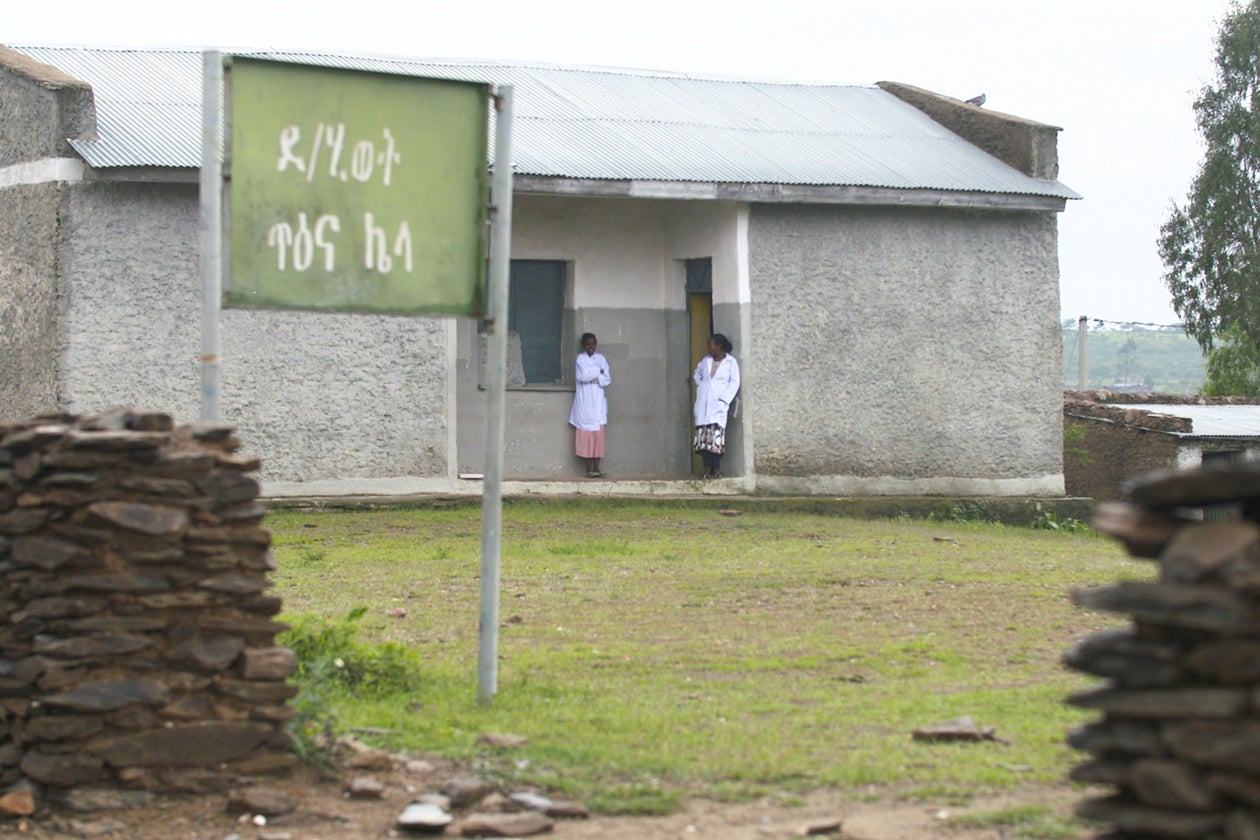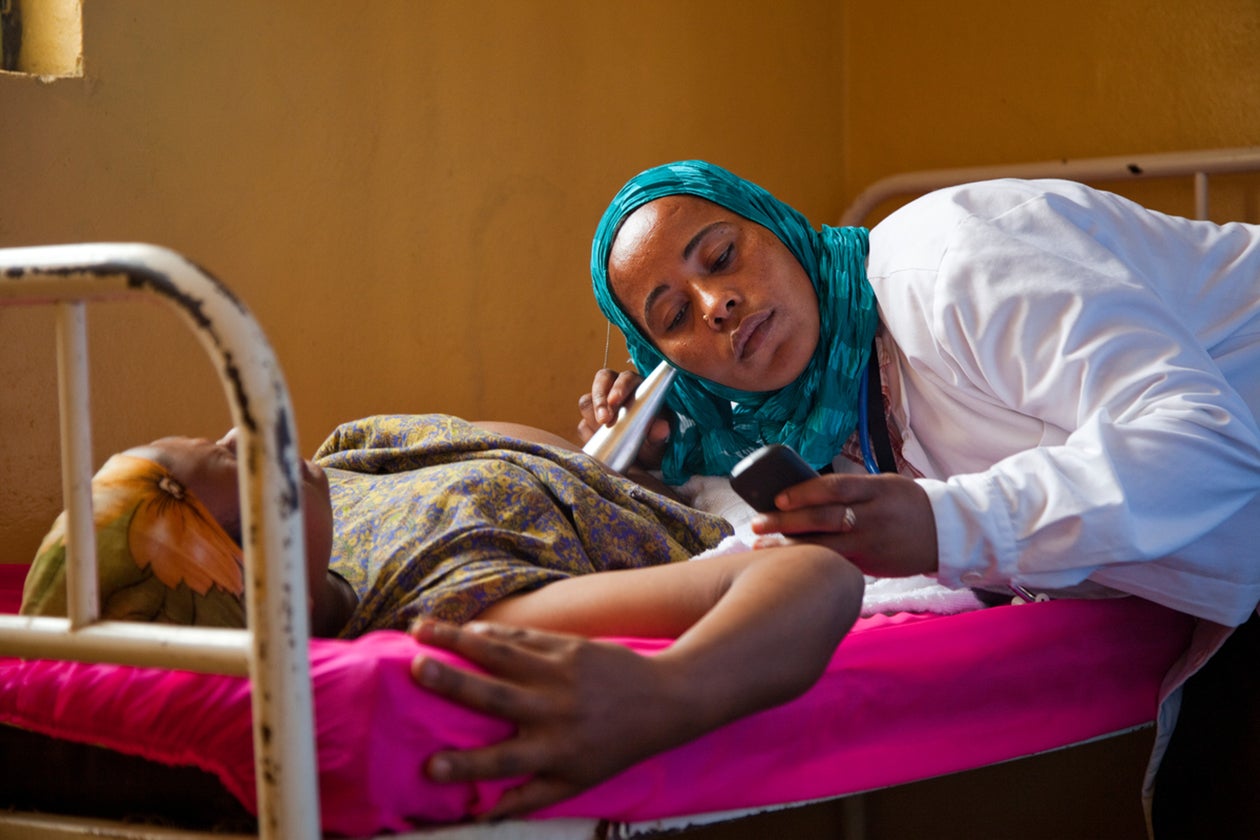Key Points
About 80 percent of Ethiopia’s population lives in rural areas where they traditionally have had little access to improved water sources, sanitation, electricity, and healthcare.
As Ethiopia recovered from 17 years of political instability and war, donors made a commitment to help the country reach its development targets. Per capita donor health expenditure increased from $16 in 2005 to $24 in 2015 (in 2017 PPP dollars) - making the country one of the top ten recipients of aid in the world.
Despite recent robust economic growth that has allowed the federal health budget to grow, the country’s $81 total health expenditure per capita as of 2015 is still well below the $202 average in sub-Saharan Africa (excluding high-income countries (in 2017 PPP).
Access to healthcare has been particularly challenging. In the year 2000, the country had fewer than 400 government health centers (1 for approximately 150,000 people) and one of the worst doctor-patient ratios in the world at 1:48,000. Most of those scant clinics and doctors were in urban areas. Between 1995 and 2000, only 42 percent of rural residents lived within 10 kilometers (or two hours’ walk) of a health facility according to Ethiopia’s Demographic Health Survey.
As a result, in 2002, nearly half of all deaths in the country were due to malaria, TB, and pneumonia - all readily preventable and treatable conditions that do not require sophisticated health care.
Ethiopia struggled to develop programs that could overcome this chasm and reach its rural populations with basic services.
In 1994, the federal government enacted a new constitution, which adopted decentralization as a national strategy. This was very much in line, at the time, with recommendations from institutions like the World Health Organization. Decentralization was promoted as a way for countries to bypass ineffective or unresponsive national bureaucracies and allow communities to plan, lead, and manage their own health care programs. In Ethiopia’s case, decentralization was also seen as an important step towards sub-national autonomy in an ethnically heterogenous country.
In 2002, Ethiopia further decentralized from the regional level to the woreda level (district). This decentralization, in which districts were given block grants to fund their own programming, would play a role in Ethiopia’s successful implementation of CHW programming.
In Ethiopia’s decentralized system, leaders from hundreds of woredas across the country mobilized their own resources to implement the Health Extension Program to meet their community’s urgent needs and follow clear directives from top political leaders.
During the early aughts there were a few concurrent trends that created an environment conducive to the Health Extension Program’s success.
First, Ethiopia’s GDP growth averaged a robust 10.7 percent annual GDP growth from 2005 to 2014. This allowed the country to begin to spend more on healthcare, and it did; per capita government health expenditure rose from $2.05 in 2005 to $8.51 in 2014.
This robust economic growth gave Ethiopia the funds to support a broad array of important infrastructure improvements, such as increasing access to clean water, improved sanitation, and education.
Ethiopia is also unusual in the political stability it experienced during this time frame. Meles Zenawi, who was deeply involved in the design and implementation of the Health Extension Program, led the Ethiopian government, as either prime minister or president of the transitional government, from 1991 to 2012, when he died in office. His political party, the Ethiopian People's Revolutionary Democratic Front, was highly supportive of his initiatives and leveraged its considerable political power and administrative structures at regional, district, and village levels to ensure attention and resources were directed to support Zenawi’s flagship program.
National Network of Health Care Facilities
The Health Extension Program would not have been nearly as impactful if not for the concurrent introduction of the Accelerated Expansion of Primary Health Care Coverage. This expanded the number of primary health care facilities (i.e. health posts, health centers and referral hospitals), and increased the number of nurses, health extension workers and supervisory and administrative staff.
The expanded network of facilities created an integrated national network of care, reaching from rural health posts to urban hospitals. Previously, a few hundred health centers existed, mostly in urban areas. With the expansion, the government constructed 3,000 health centers that formed a network with the Health Extension Program’s 16,000 health posts, to provide a continuum of care for patients and supervision and support for Health Extension Workers.
A 2017 study found the simultaneous combination of investments in primary health care-level facilities and staff was critical to the success in scaling service delivery and ultimately, to achieving the health-related MDGs.

Increased number of trained health professionals
It is important to recognize that supportive supervision is key to Health Extension Workers’ success. The Accelerated Expansion of Primary Health Care Coverage, in addition to building new facilities, increased the nurse-population ratio from approximately 1:9,000 in 2000, to 1:3,000 in 2010, and the health officer-population ratio also improved from 1:225,000 in 2000, to 1:28,000 in 2010- bolstering staffing at health centers.
These staff, distributed in the national network of health centers, provided regular supervision that was responsive to the needs of Health Extension Workers.

Increased Funding
A significant increase in funding was required to roll out the Health Extension Program and significant funding has been required to continue the program each year.
Ethiopia’s robust economic growth (10.7 percent annual GDP growth from 2005 to 2014) allowed the country to begin spending more on health care, and it did; per capita government health expenditure rose from $11 in 2005, to $14 in 2014.
At the same time, Ethiopia’s growing resources were complemented by remarkable support from donors. Per capita donor health expenditure increased from $16 in 2005, to $30 in 2014.
One recent study found that between 2001 and 2011, per capita donor funding to primary health care in Ethiopia increased by over 400 percent, compared to only 60 percent in Nigeria, a country with a similar overall donor budget envelope. The notable increase in international aid to Ethiopia over the last two decades has made Ethiopia one of the ten largest recipients of aid in the world. Nevertheless, it is important to remember that the $81 total health expenditure per capita in Ethiopia is still well below the $202 average in sub-Saharan Africa.
Decentralization policies
A World Bank case study found “the implementation of the HEP could not have been successful without a series of national policies creating an enabling socioeconomic and political environment. These include devolution policy, civil service policy, vocational education policy, and health policy”.10
